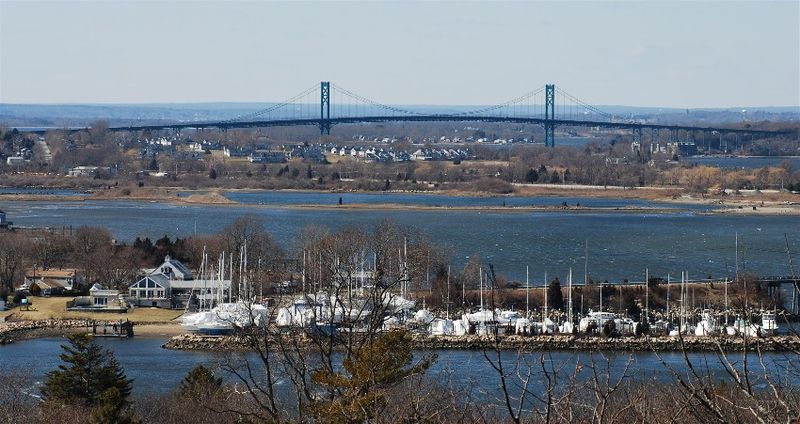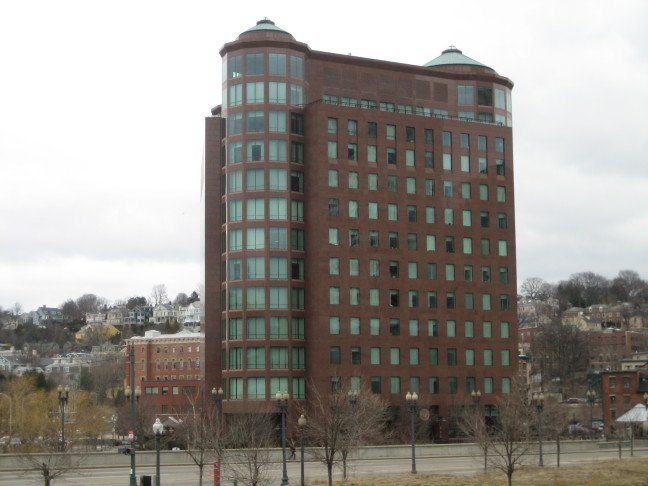 |
| Providence Union Station--back in the day |
 |
| New Haven in eastern MA and RI |
 |
| Slade's Ferry Bridge--a lost asset |
 |
| Fig. 1. Historical NH alignments from Providence SE. |
Follow the alignments, however, and you'll notice a pattern. Two major alignments historically linked Providence and Newport; they diverged at Fall River. One route linked to the Bristol branch at Warren; the other route ran up to Taunton and around via Attleboro back to Providence. Both are highly inferior alignments today. The implication is that any workable commuter rail from Providence southeast, which hits the four natural termini, must of necessity deal with the region's challenging topography--specifically its strewn-about fjordlike bays.
 |
| Mount Hope Bay |
Across the Taunton
Let us first turn our attention to the Fall River-New Bedford line (FRNB for short). This route is the unification of three discrete routes:
- The Somerset Branch, a trace alignment the New Haven abandoned at least prior to 1948. This alignment is salvageable from the junction with the Bristol Branch east to the Lee River crossing, just beyond which the Brayton Point power plant has obliterated the ROW*. This route used to extend across Slade's Ferry Bridge into Fall River.
- A Taunton River crossing.
- The Watuppa Branch, a good-quality easement from the former mills at the head of the Quequechan to New Bedford.
- The I-195 alignment across the Braga Bridge and under Falls River
- The Slade's Ferry alignment with a new alignment built up the Quequechan's remnants to the Watuppa Branch.
The other connection needing to be made is the on the Bristol-Newport line (BN for short, heh). This line has been assembled together for the following three reasons:
- Remember what we said about a single-bridge alignment and excessive branching?
- A Taunton crossing following the I-195 alignment will by necessity make a cutoff down to the old NH alignment extremely difficult, and furthermore, impinge on potential station sites. No, it is better here to have the station to Boston riverside, and the one to Providence downtown.
- As previously stated, a Providence-Fall River-Newport alignment is relatively circuitous. If we want to optimize for straightness (and stay of out Massachusetts), we want a Providence-Bristol-Newport alignment.
On the Aquidneck Island (Newport) side of the bay, this is easy. The NH alignment closely parallels the shore, and the geography allows for a gentle turn onto a bay crossing. Any ramp up can be built alongside the existing alignment.
Far harder is the Bristol Peninsula. The former NH alignment there ran water level as well, but ended in downtown Bristol. Extending from it would require carving out a new waterfront easement, as well as raising track level to the clearance required across Mount Hope Bay.
Far better is a power alignment heading straight down the center of the peninsula. This alignment only extends as far south as Gooding Avenue, however. Extending it further requires cutting through a smallish park and following metes-and-bounds boundaries to minimize takings; it is possible to continue the alignment without significant disruption until between State and Franklin Streets.
At State, entering into a section of town becomes unavoidable; even with an alignment designed to run behind street lots, properties will have to be taken at the cross streets. At Mount Hope Avenue, the optimal easement course curves across Dewolf Avenue through a couple of largish empty lots to run behind Antony Avenue. This, among other things, brings it across the buildup border at Woodlawn Avenue in the woods south of Wolf Cemetery. The proposed route then curves along Metacom Avenue and Ferry Road, alongside Roger Williams University, as it prepares to cross Mount Hope Bay.
Finally, a note: Accessing the power line easement from the Somerset branch in Warren will almost certainly require construction over a fairly large cemetery.
The new Bristol train station would be sited at Franklin Street, where some light industry would be redeveloped into TOD. Indeed, this whole route parallels an extended section of light industry on the east side of Bristol. This may be of use in developing lineside customers.
 |
| Mount Hope Bridge |
Actually, due to the relative age of the current bridge (while the structure is pretty, several obvious deficiencies make it a poster child for functional obsolescence), a multimodal reconstruction may well be called for. Figure 4 below shows how a new alignment through Bristol would work with the existing ones.
 |
| Fig. 4. Mount Hope Bay crossing and a new alignment through Bristol, up to Warren. |
Two potential alignments could be made into central Providence from the East Side Railroad Tunnel. The first is Option D, as I described the other day as
...link[ing] Providence Station with the old East Side line. Unlike Option C, it does so far closer to the city, linking a short bore tunnel under the Moshassuck and part of College Hill with the existing East Side Railroad Tunnel and running across the Crook Point Bridge.and the second is Alon Levy's countersuggestion that
for Providence-centric regional rail, it would be interesting to demolish either One Citizens Plaza or the buildings at the northeast corner of Steeple and Canal and go elevated over either Memorial or Kennedy Plaza).
 |
| One Citizens Plaza |
While either way works, I am of the opinion that the short (~4400 feet or 1.4 km) cutoff tunnel to the existing station works better in a larger picture. S-Bahn networks, in particular, like to cluster at the core. That said, since Alon's alignment is a reflection of the NH one, and the railroad also had an alignment up the Seekonk--one still in use today--a network built around a new station over Memorial Drive at Union Station is very much practicable as well. Figure 5 shows how the bored (red) and elevated (black) alignments interact with the existing one (blue).
 |
| Fig. 5. Tunneled (red) and elevated (black) approaches to DT Providence from the East Side Tunnel (blue). |
Having found the existing easements out of Providence southeast, and analyzed the infrastructural challenges required in turning them into a line (or two), we now have the beginnings of a high-quality statewide network centered in Providence. These southeastern routes are infrastructurally the most challenging; we'll look at other routes later. For now, our final result is Figure 6.
 |
| Fig. 6. Regional rail from Providence southeast |
*Note that, with Brayton Point's planned 2017 shutdown, opportunity may be had to re-establish the ROW. This would greatly ease curvature from the Somerset Branch onto the I-195 alignment.



If the main alignment into Providence is via the East Side Tunnel, then there should also be a line going north toward Attleboro.
ReplyDeleteYou'll get your wish soon enough. For this post, I was concentrating on the southeast.
ReplyDelete